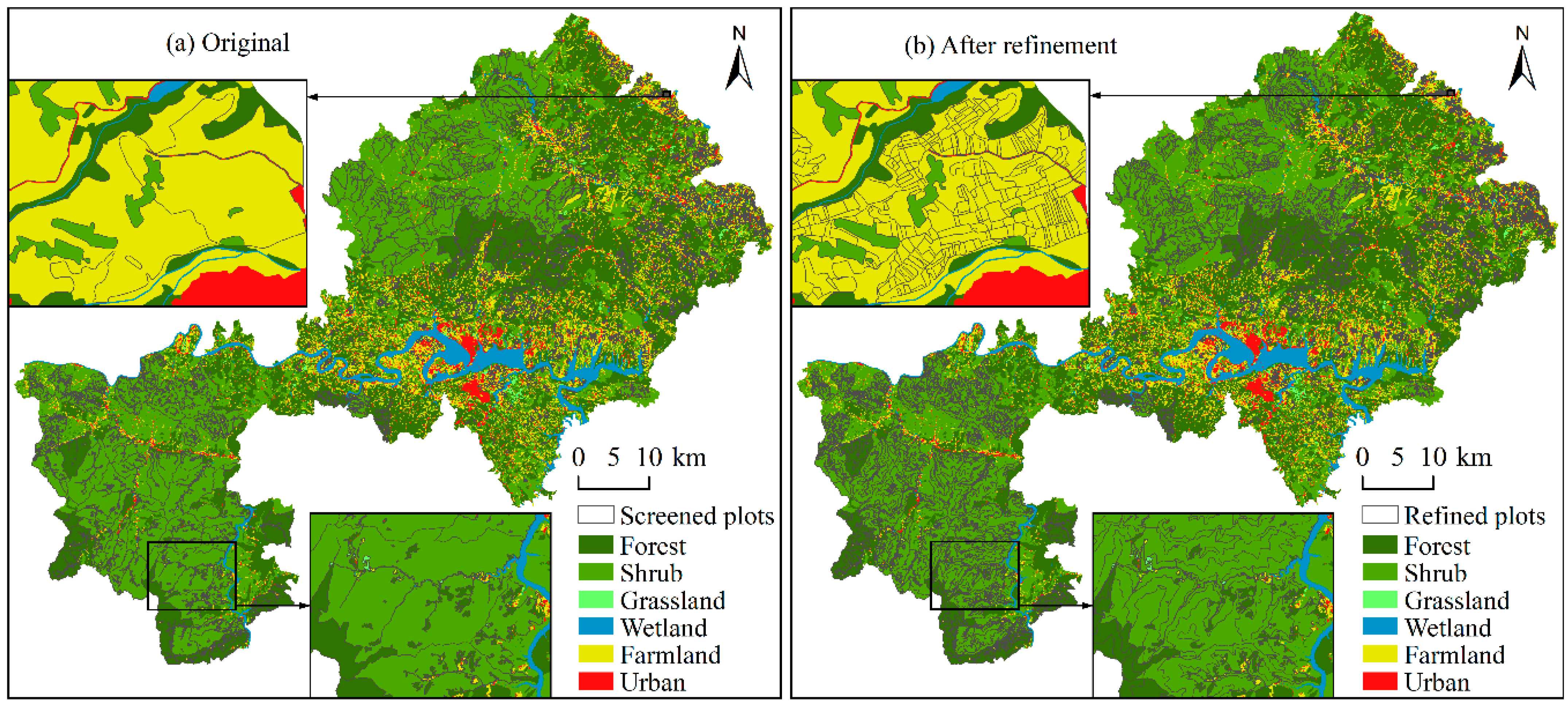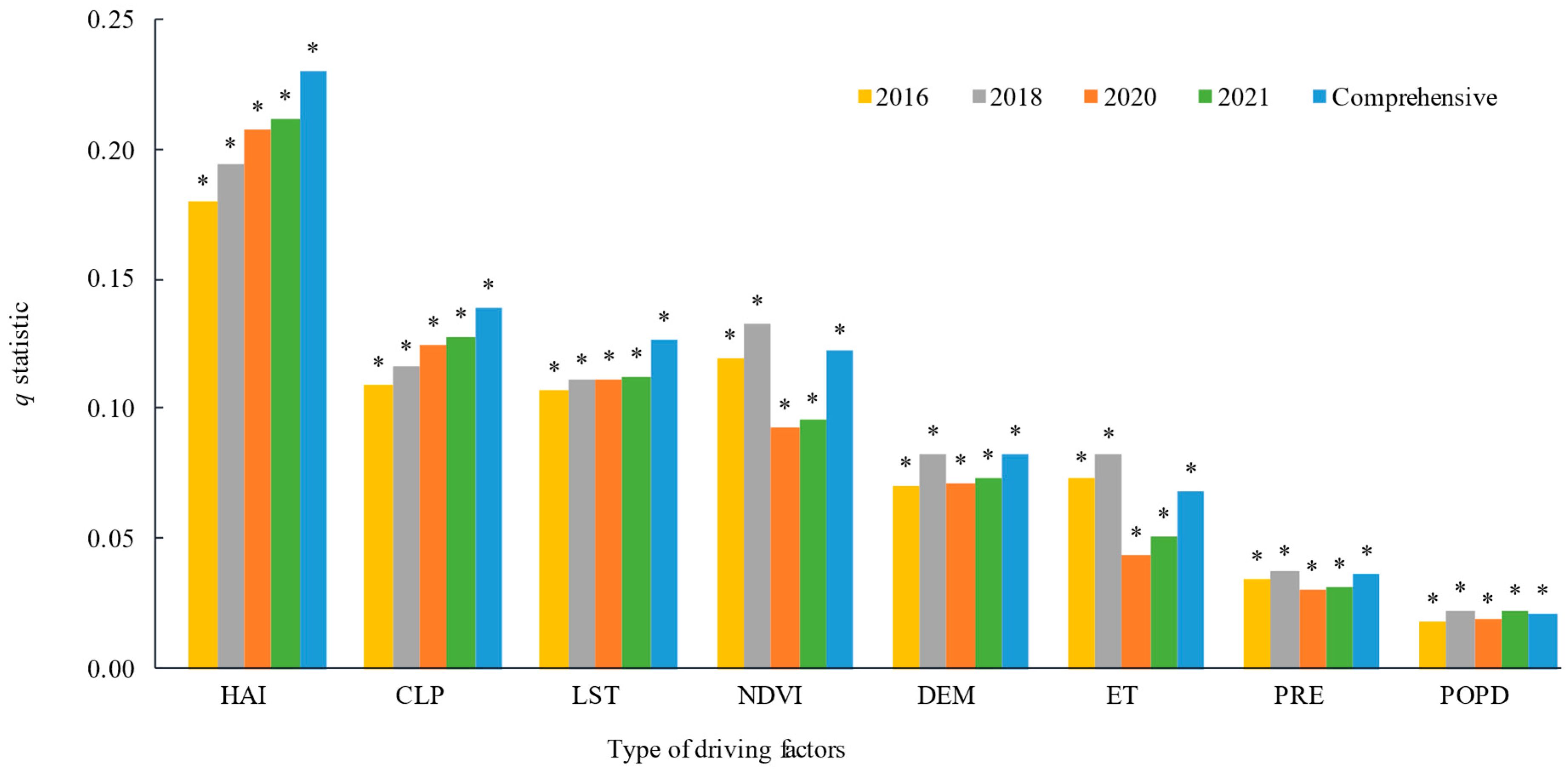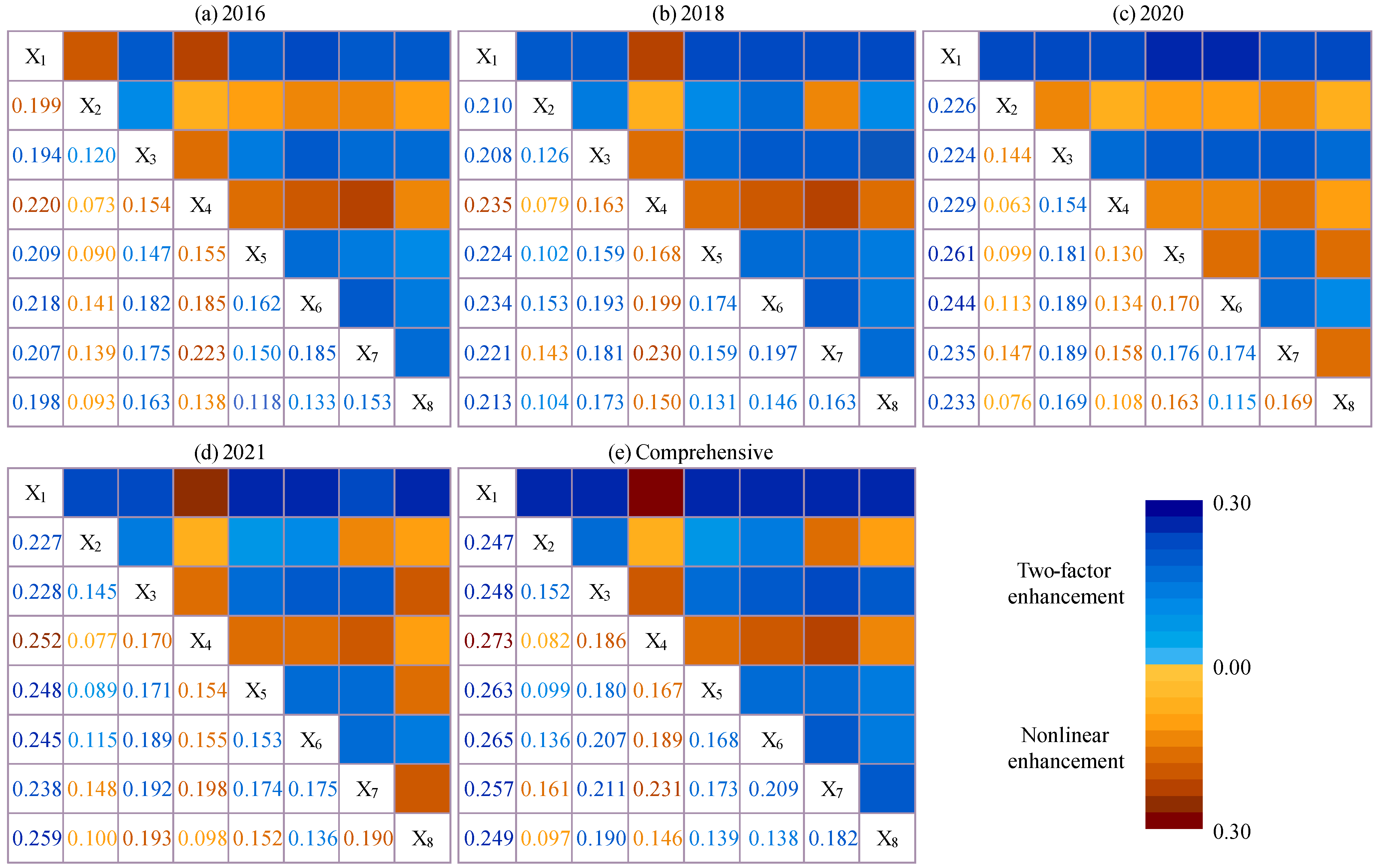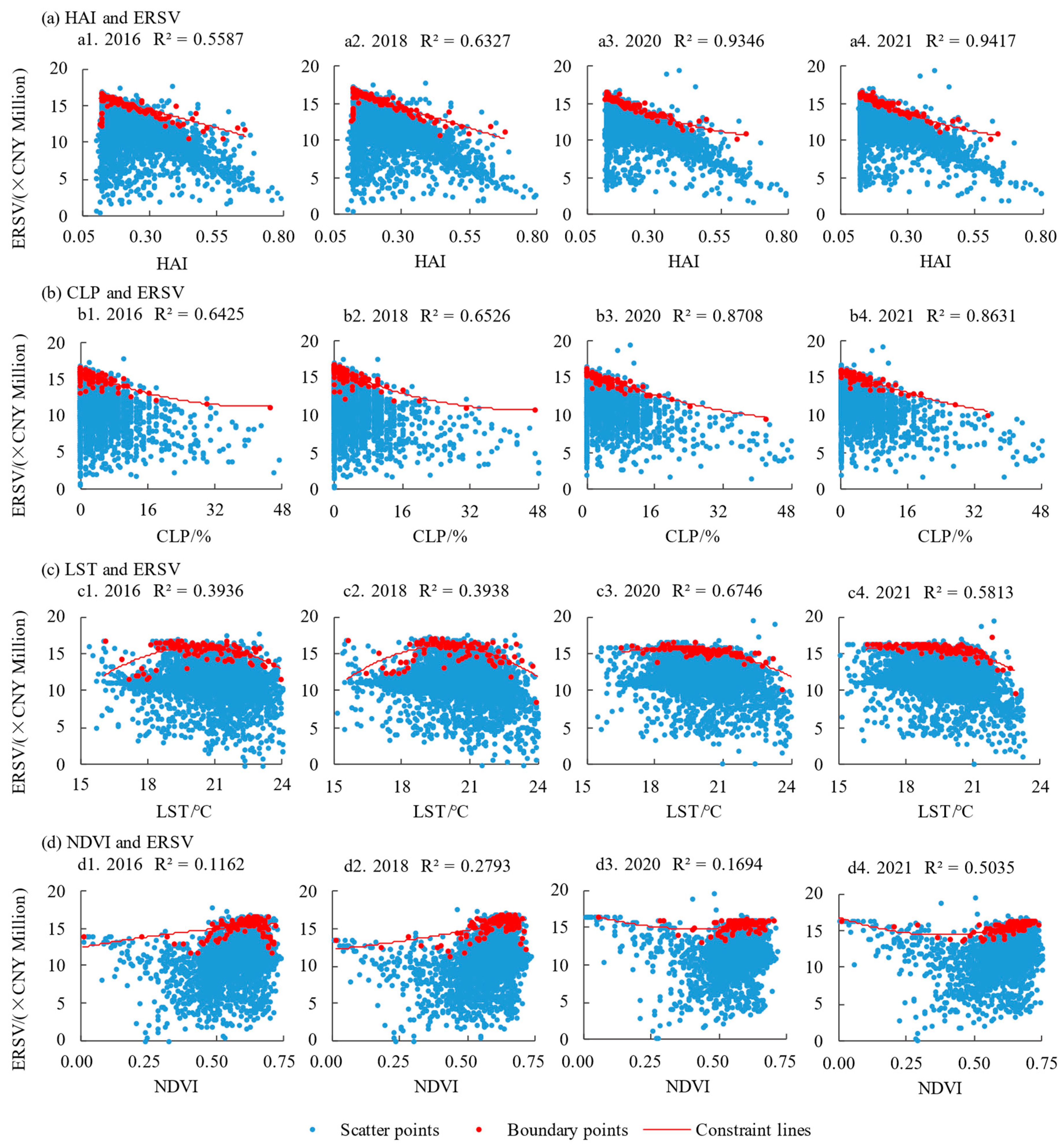Spatiotemporal Characteristics and Driving Factors of Ecosystem Regulation Services Value at the Plot Scale
Abstract
:1. Introduction
2. Material and Methods
2.1. Study Area
2.2. Data Source and Processing
2.2.1. Ecological Plot Data
2.2.2. Driving Factors and Accounting Index Parameter Data
2.3. Methodology
2.3.1. ERSV Accounting Model at the Plot Scale
2.3.2. The Method of Barycentric Analysis
2.3.3. The Optimal Parameters-Based Geographical Detector Model (OPGD)
2.3.4. The Extraction Method of Constraint Lines
3. Results and Analysis
3.1. Spatial and Temporal Dimension Analysis of ERSV in Yunyang District
3.1.1. Temporal Dimension Analysis of ERSV
3.1.2. Spatial Dimension Analysis of ERSV
3.2. Analysis of Driving Factors for the Spatial Differentiation of ERSV
3.3. Analysis of the Constraint Relationship between the Major Driving Factors and ERSV
4. Discussion
4.1. Calculation and Spatiotemporal Characteristics of ERSV at the Plot Scale
4.2. Driving Factors of ERSV at the Plot Scale
4.3. Uncertainty Analysis and Prospect
- (1)
- The accounting of ERSV involves multiple disciplines, resulting in the poor comparability of the results [22]. In this study, only nine ESs were selected to calculate ERSV, and the negative oxygen ion and noise reduction function values were not included, resulting in a low ERSV calculation result. In addition, the multi-source raster data were resampled to 5 m × 5 m in this study, allowing for the calculation and analysis of ERSV at the plot scale. However, the nature of the data was not considered, and no analysis or verification was conducted, potentially increasing the uncertainty of the results. In future studies, it would be beneficial to develop selection and accounting criteria for regional ecosystem service indicators based on the ecological background characteristics and project requirements of the study area. Additionally, appropriate interpolation methods and resolutions should be chosen through experimental verification to achieve a more accurate and comprehensive quantitative study of ERSV.
- (2)
- This paper examines the factors that drive ERSV and establishes a relationship between ERSV and major anthropogenic and natural drivers. However, in practical management, more attention is given to how these drivers impact the value of individual ecosystem service functions. Additionally, due to the limited access to continuous data on driving factors such as CO2 emissions and GDP, they were not included in the analysis. This may affect the scientific validity of the research and its conclusions. In future studies, a more comprehensive and diverse range of driving factor indictors should be considered for the analysis. Furthermore, the spatial and temporal characteristics, as well as the driving factors and constraint line relationships of ecosystem service function values, should be integrated into management practices to inform more targeted and scientifically sound decision-making.
5. Conclusions
- (1)
- In the temporal dimension, the ERSV in Yunyang District showed a small decrease at first and then a continuous increase from 2016 to 2021, with an overall increase of CNY 1.664 billion and a growth rate of 3.68%. The contribution values of the climate regulation function and water retention function to ERSV were significant.
- (2)
- In the spatial dimension, ERSV was distributed higher in the north and south and lower in the middle. The high-value areas were mainly located in woodland and wetland areas with high unit ERSVs. The center of gravity of the ERSV increase shifted to the southwest by 12,455.42 m, while the center of gravity of the reduction shifted to the southwest by 3582.79 m from 2016 to 2021.
- (3)
- The analysis of driving factors showed that the HAI and CLP were the leading anthropogenic factors, while the LST and NDVI were the leading natural factors. The interaction between any two factors showed nonlinear enhancement or two-factor enhancement characteristics, and the interaction between HAI and natural factors and LST and anthropogenic factors greatly enhanced the explanatory power regarding the spatial differentiation of ERSV.
- (4)
- The HAI, CLP, and LST all had a negative inhibitory effect on the ERSV, while the NDVI had a positive promoting effect overall. The ERSV was able to maintain a consistently high value output when the HAI was below 0.3, CLP was below 15%, LST was between 18 and 22 °C, and NDVI was greater than 0.5.
Author Contributions
Funding
Institutional Review Board Statement
Informed Consent Statement
Data Availability Statement
Conflicts of Interest
References
- Daily, G.C. Nature’s Services: Societal Dependence on Natural Ecosystems; Island Press: Washington, DC, USA, 1997. [Google Scholar]
- Ouyang, Z.; Wang, X.; Miao, H. A primary study on Chinese terrestrial ecosystem services and their ecological economic values. Acta Ecol. Sin. 1999, 19, 607–613. [Google Scholar]
- Costanza, R.; d’Arge, R.; de Groot, R.; Farber, S.; Grasso, M.; Hannon, B.; Limburg, K.; Naeem, S.; O’Neill, R.V.; Paruelo, J.; et al. The value of the world’s ecosystem services and natural capital. Nature 1997, 387, 253–260. [Google Scholar] [CrossRef]
- Fu, B.; Zhou, G.; Bai, Y.; Song, C.; Liu, J.; Zhang, H.; Lu, Y.; Zheng, H.; Xie, G. The Main Terrestrial Ecosystem Services and Ecological Security in China. Adv. Earth Sci. 2009, 24, 571–576. [Google Scholar]
- Ouyang, Z.Y.; Zheng, H.; Xiao, Y.; Polasky, S.; Liu, J.G.; Xu, W.H.; Wang, Q.; Zhang, L.; Xiao, Y.; Rao, E.M.; et al. Improvements in ecosystem services from investments in natural capital. Science 2016, 352, 1455–1459. [Google Scholar] [CrossRef]
- Xie, G.; Zhang, C.; Zhang, C.; Xiao, Y.; Lu, C. The value of ecosystem services in China. Resour. Sci. 2015, 37, 1740–1746. [Google Scholar]
- Ouyang, Z.; Song, C.; Zheng, H.; Polasky, S.; Xiao, Y.; Bateman, I.J.; Liu, J.; Ruckelshaus, M.; Shi, F.; Xiao, Y.; et al. Using gross ecosystem product (GEP) to value nature in decision making. Proc. Natl. Acad. Sci. USA 2020, 117, 14593–14601. [Google Scholar] [CrossRef]
- Song, C.; Ouyang, Z. Gross Ecosystem Product accounting for ecological benefits assessment: A case study of Qinghai Province. Acta Ecol. Sin. 2020, 40, 3207–3217. [Google Scholar]
- Ouyang, Z.; Zhu, C.; Yang, G.; Xu, W.; Zheng, H.; Zhang, Y.; Xiao, Y. Gross ecosystem product: Concept, accounting framework and case study. Acta Ecol. Sin. 2013, 33, 6747–6761. [Google Scholar] [CrossRef]
- Wang, L.; Xiao, Y.; Ouyang, Z.; Wei, Q.; Bo, W.; Zhang, J.; Ren, L. Gross ecosystem product accounting in the national key ecological function area: An example of Arxan. China Popul. Resour. Environ. 2017, 27, 146–154. [Google Scholar]
- Pema, D.; Xiao, Y.; Ouyang, Z.; Wang, L. Gross ecosystem product accounting for the Garze Tibetan Autonomous Prefecture. Acta Ecol. Sin. 2017, 37, 6302–6312. [Google Scholar]
- Ma, G.; Yu, F.; Wang, J.; Zhou, X.; Yuan, J.; Mou, X.; Zhou, Y.; Yang, W.; Peng, F. Measuring gross ecosystem product (GEP) of 2015 for terrestrial ecosystems in China. China Environ. Sci. 2017, 37, 1474–1482. [Google Scholar]
- Pema, D.; Xiao, Y.; Ouyang, Z.; Wang, L. Assessment of ecological conservation effect in Xishui county based on gross ecosystem product. Acta Ecol. Sin. 2020, 40, 499–509. [Google Scholar]
- Liu, J.G.; Viña, A.; Yang, W.; Li, S.X.; Xu, W.H.; Zheng, H. China’s Environment on a Metacoupled Planet. In Annual Review of Environment and Resources; Gadgil, A., Tomich, T.P., Eds.; Annual Reviews, Palo Alto: Santa Clara, CA, USA, 2018; Volume 43, pp. 1–34. [Google Scholar]
- Ouyang, Z.; Lin, Y.; Song, C. Research on Gross Ecosystem Product(GEP): Case study of Lishui City, Zhejiang Province. Environ. Sustain. Dev. 2020, 45, 80–85. [Google Scholar]
- Millennium Ecosystem Assessment (MEA). Ecosystems and Human Well-Being: A Framework for Assessment; Island Press: Washington, DC, USA, 2005. [Google Scholar]
- Li, F.Z.; Yin, X.X.; Shao, M. Natural and anthropogenic factors on China’s ecosystem services: Comparison and spillover effect perspective. J. Environ. Manag. 2022, 324, 9. [Google Scholar] [CrossRef] [PubMed]
- Shen, J.S.; Li, S.C.; Wang, H.; Wu, S.Y.; Liang, Z.; Zhang, Y.T.; Wei, F.L.; Li, S.; Ma, L.; Wang, Y.Y.; et al. Understanding the spatial relationships and drivers of ecosystem service supply-demand mismatches towards spatially-targeted management of social-ecological system. J. Clean. Prod. 2023, 406, 14. [Google Scholar] [CrossRef]
- Xu, X.B.; Yang, G.S.; Tan, Y. Identifying ecological red lines in China’s Yangtze River Economic Belt: A regional approach. Ecol. Indic. 2019, 96, 635–646. [Google Scholar] [CrossRef]
- Yang, M.; Xiao, Y.; Ouyang, Z.; Ye, H.; Deng, M.; Ai, L. Ecosystem regulation services accounting of gross ecosystem product (GEP) in Sichuan province. J. Southwest Minzu Univ. 2019, 45, 221–232. [Google Scholar]
- Chen, M.; Ji, R.; Liu, X.; Liu, C.; Su, L.; Zhang, L. Gross ecosystem product accounting for Two Mountains’ Bases and transformation analysis: The case study of Ninghai County. Acta Ecol. Sin. 2021, 41, 5899–5907. [Google Scholar]
- Mou, X.; Wang, X.; Zhang, X.; Rao, S.; Zhu, Z. Accounting and Mapping of Gross Ecosystem Product in Yanqing District, Beijing. Res. Soil Water Conserv. 2020, 27, 265–274+282. [Google Scholar]
- Chen, H.; Wang, Y.; Huang, Y.; Wu, B.; Lai, W. Evaluation of Regional Ecosystem Services Grade Coupling Ecological Carrying Capacity and Gross Ecosystem Product—A Case Study of Changting County, Fujian Province. J. Soil Water Conserv. 2021, 35, 150–160. [Google Scholar]
- Hu, C.; Zou, B.; Liang, Y.; He, C.; Lin, Z. Spatio-temporal evolution of gross ecosystem product with high spatial resolution: A case study of Hunan Province during 2000–2020. Remote Sens. Nat. Resour. 2023, 35, 179–189. [Google Scholar]
- Jiang, S. Gross Ecosystem Product Accounting with its Spatio-Temporal Evolution of Shaanxi Province; Northwest A&F University: Xianyang, China, 2021. [Google Scholar]
- Yu, M.; Jin, H.; Li, Q.; Yao, Y.; Zhang, Z. Gross Ecosystem Product (GEP) Accounting for Chenggong District. J. West China For. Sci. 2020, 49, 41–48+55. [Google Scholar]
- Hao, C.; Wu, S.; Zhang, W.; Chen, Y.; Ren, Y.; Chen, X.; Wang, H.; Zhang, L. A critical review of Gross ecosystem product accounting in China: Status quo, problems and future directions. J. Environ. Manag. 2022, 322, 14. [Google Scholar] [CrossRef]
- Wang, Y.; Ding, J.; Li, X.; Zhang, J.; Ma, G. Impact of LUCC on ecosystem services values in the Yili River Basin based on an intensity analysis model. Acta Ecol. Sin. 2022, 42, 3106–3118. [Google Scholar]
- Zeng, C.; Li, Y.; Duan, X.; Xu, Y. Assessment and Driving Force Analysis of Ecosystem Service Value in the Urban Agglomeration Along the Middle Reaches of the Yangtze River. Res. Soil Water Conserv. 2022, 29, 362–371. [Google Scholar]
- Li, Z.; Chen, J.; Zhang, W.; Lei, L.; Sha, Z. Analysis of evolution and influencing factors of ecosystem service value in Hubei Province. Sci. Surv. Mapp. 2023, 48, 245–257. [Google Scholar]
- Zheng, X.; Chen, Y.; Zheng, Z.; Guo, C.; Huang, Z.; Zhou, Y. Dynamic Changes of Ecosystem Service Value and Evolution of Its Influencing Factors in Hubei Province. Ecol. Environ. Sci. 2023, 32, 195–206. [Google Scholar]
- Yan, E.; Lin, H.; Wang, G.; Xia, C. Analysis of evolution and driving force of ecosystem service values in the Three Gorges Reservoir region during 1990–2011. Acta Ecol. Sin. 2014, 34, 5962–5973. [Google Scholar]
- Chinese Academy of Environmental Planning, Research Center for Eco-Environmental Sciences. The Technical Guideline on Gross Ecosystem Product (GEP). 2020. Available online: https://www.caep.org.cn/zclm/sthjyjjhszx/zxdt_21932/202010/W020201029488841168291.pdf (accessed on 16 July 2023).
- National Development and Reform Commission of China, National Bureau of Statistics of China. The Code for Gross Ecological Product Accounting; People’s Publishing House: Beijing, China, 2022. [Google Scholar]
- Fu, J.; Zhang, Q.; Wang, P.; Zhang, L.; Tian, Y.; Li, X. Spatio-Temporal Changes in Ecosystem Service Value and Its Coordinated Development with Economy: A Case Study in Hainan Province, China. Remote Sens. 2022, 14, 970. [Google Scholar] [CrossRef]
- Yuan, H.; Yan, J.; Zhang, J.; Wang, Z.; Xu, W.; Zhang, H. Influences of climate change and human activities on vegetation phenology of Shanghai. Acta Ecol. Sin. 2023, 43, 8803–8815. [Google Scholar]
- Wang, J.; Xu, C. Geodetector: Principle and prospective. Acta Geogr. Sin. 2017, 72, 116–134. [Google Scholar]
- Song, Y.Z.; Wang, J.F.; Ge, Y.; Xu, C.D. An optimal parameters-based geographical detector model enhances geographic characteristics of explanatory variables for spatial heterogeneity analysis: Cases with different types of spatial data. Giscience Remote Sens. 2020, 57, 593–610. [Google Scholar] [CrossRef]
- Li, Y.; Geng, H.C. Spatiotemporal trends in ecosystem carbon stock evolution and quantitative attribution in a karst watershed in southwest China. Ecol. Indic. 2023, 153, 13. [Google Scholar] [CrossRef]
- Hao, R.; Yu, D.; Wu, J.; Guo, Q.; Liu, Y. Constraint line methods and the applications in ecology. Chin. J. Plant Ecol. 2016, 40, 1100–1109. [Google Scholar]
- Fang, L.; Xu, D.; Wang, L.; Niu, Z.; Zhang, M. The study of ecosystem services and the comparison of trade-off and synergy in Yangtze River Basin and Yellow River Basin. Geogr. Res. 2021, 40, 821–838. [Google Scholar]
- Li, D.L.; Cao, W.F.; Dou, Y.H.; Wu, S.Y.; Liu, J.G.; Li, S.C. Non-linear effects of natural and anthropogenic drivers on ecosystem services: Integrating thresholds into conservation planning. J. Environ. Manag. 2022, 321, 11. [Google Scholar] [CrossRef] [PubMed]
- Jiu, J. Study on the Implication of Land Use Change on Ecosystem Service Value in Hubei Province; Huazhong University of Science and Technology: Wuhan, China, 2021. [Google Scholar]
- He, Y.; Sheng, M.; Lei, L.; Guo, K.; He, Z. Driving factors and spatio-temporal distribution on NO2 and CO2 in the Yangtze River Delta. China Environ. Sci 2020, 42, 3544–3553. [Google Scholar]
- Wang, R.; Zhang, H.; Qiang, W.; Li, F.; Peng, J. Spatial characteristics and influencing factors of carbon emissions in county-level cities of China based on urbanization. Prog. Geogr. 2021, 40, 1999–2010. [Google Scholar] [CrossRef]








| Year | Number of the Original Plots | Number of the Screened Plots | Number of Plots after Refinement | Minimum Plot Area/m2 |
|---|---|---|---|---|
| 2016 | 62,772 | 1132 | 111,278 | 30.34 |
| 2018 | 65,100 | 1089 | 113,836 | 31.06 |
| 2020 | 105,730 | 722 | 118,325 | 30.80 |
| 2021 | 106,132 | 586 | 119,211 | 30.32 |
| Type | Factors | Resolution | Year | Data Source and Processing |
|---|---|---|---|---|
| Anthropogenic factor | HAI | 100 m | 2016 2018 2020 2021 | The mathematical model constructed by Yan et al. [32] was used for calculation based on the ecological plot data and rasterized to 100 m × 100 m. |
| POPD/(person·km−2) | 1 km | Based on the LandScan Global Population Data (https://landscan.ornl.gov/) (accessed on 11 July 2023), and the vector border of the Yunyang District was used to extract the mask. | ||
| CLP/% | 1 km | The proportion of construction land in the area of each 1 km × 1 km fishing net unit was calculated based on ArcGIS10.8 software. | ||
| Natural factor | DEM/m | 30 m | 2019 | Based on the ASTER GDEM V3 data provided by the Geospatial Data Cloud (http://www.gscloud.cn/) (accessed on 6 September 2022), and the vector border of the Yunyang District was used to extract the mask. |
| PRE/mm | 1 km | 2016 2018 2020 2021 | Based on the 1 km monthly precipitation dataset for China provided by the National Tibetan Plateau Scientific Data Center (https://data.tpdc.ac.cn/) (accessed on 11 July 2023) and synthesized by the pixel-by-pixel sum. | |
| NDVI | 250 m | Based on the MODIS-NDVI monthly synthesis product provided by the PIESAT (https://engine.piesat.cn/) (accessed on 13 July 2023) and synthesized by the pixel-by-pixel average. | ||
| LST/°C | 1 km | Based on the NASA (https://earthdata.nasa.gov/) (accessed on 10 July 2023) MOD11A2 Data Products and synthesized by the pixel-by-pixel average. | ||
| ET/mm | 500 m | Based on the NASA (https://earthdata.nasa.gov/) (accessed on 10 July 2023) MOD16A2 Data Products and synthesized by the pixel-by-pixel sum. |
| Services | Value/(× CNY 10−1·Billion) | Increment/(× CNY 10−1·Billion) | Increment Percentage/% | |||||||||
|---|---|---|---|---|---|---|---|---|---|---|---|---|
| 2016 | 2018 | 2020 | 2021 | 2016–2018 | 2018–2020 | 2020–2021 | 2016–2018 | 2018–2020 | 2020–2021 | |||
| Water retention | 98.86 | 88.52 | 91.08 | 95.84 | −10.34 | 2.56 | 4.76 | −10.46 | 2.89 | 5.23 | ||
| Soil retention | 54.61 | 54.98 | 55.87 | 57.22 | 0.37 | 0.89 | 1.35 | 0.68 | 1.62 | 2.42 | ||
| Sandstorm prevention | 1.16 | 1.17 | 1.19 | 1.18 | 0.01 | 0.02 | −0.01 | 0.86 | 1.71 | −0.84 | ||
| Flood mitigation | 79.78 | 83.51 | 91.70 | 86.14 | 3.73 | 8.19 | −5.56 | 4.68 | 9.81 | −6.06 | ||
| Air purification | 0.24 | 0.23 | 0.19 | 0.17 | −0.01 | −0.04 | −0.02 | −4.17 | −17.39 | −10.53 | ||
| Water purification | 0.13 | 0.13 | 0.11 | 0.11 | 0.00 | −0.02 | 0.00 | 0.00 | −15.38 | 0.00 | ||
| Carbon sequestration | 0.76 | 0.80 | 0.92 | 0.96 | 0.04 | 0.12 | 0.04 | 5.26 | 15.00 | 4.35 | ||
| Oxygen production | 16.10 | 16.22 | 18.67 | 19.02 | 0.12 | 2.45 | 0.35 | 0.75 | 15.10 | 1.87 | ||
| Climate Regulation | 200.69 | 206.05 | 204.09 | 208.33 | 5.36 | −1.96 | 4.24 | 2.67 | −0.95 | 2.08 | ||
| ERSV | 452.33 | 451.61 | 463.82 | 468.97 | −0.72 | 12.21 | 5.15 | −0.16 | 2.70 | 1.11 | ||
Disclaimer/Publisher’s Note: The statements, opinions and data contained in all publications are solely those of the individual author(s) and contributor(s) and not of MDPI and/or the editor(s). MDPI and/or the editor(s) disclaim responsibility for any injury to people or property resulting from any ideas, methods, instructions or products referred to in the content. |
© 2024 by the authors. Licensee MDPI, Basel, Switzerland. This article is an open access article distributed under the terms and conditions of the Creative Commons Attribution (CC BY) license (https://creativecommons.org/licenses/by/4.0/).
Share and Cite
He, Y.; Long, Q. Spatiotemporal Characteristics and Driving Factors of Ecosystem Regulation Services Value at the Plot Scale. Sustainability 2024, 16, 4548. https://doi.org/10.3390/su16114548
He Y, Long Q. Spatiotemporal Characteristics and Driving Factors of Ecosystem Regulation Services Value at the Plot Scale. Sustainability. 2024; 16(11):4548. https://doi.org/10.3390/su16114548
Chicago/Turabian StyleHe, Yawen, and Qingcheng Long. 2024. "Spatiotemporal Characteristics and Driving Factors of Ecosystem Regulation Services Value at the Plot Scale" Sustainability 16, no. 11: 4548. https://doi.org/10.3390/su16114548
APA StyleHe, Y., & Long, Q. (2024). Spatiotemporal Characteristics and Driving Factors of Ecosystem Regulation Services Value at the Plot Scale. Sustainability, 16(11), 4548. https://doi.org/10.3390/su16114548








